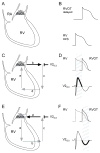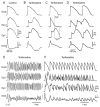The pathophysiological mechanism underlying Brugada syndrome: depolarization versus repolarization
- PMID: 20659475
- PMCID: PMC2932806
- DOI: 10.1016/j.yjmcc.2010.07.012
The pathophysiological mechanism underlying Brugada syndrome: depolarization versus repolarization
Abstract
This Point/Counterpoint presents a scholarly debate of the mechanisms underlying the electrocardiographic and arrhythmic manifestations of Brugada syndrome (BrS), exploring in detail the available evidence in support of the repolarization vs. depolarization hypothesis.
Copyright 2010 Elsevier Ltd. All rights reserved.
Figures








References
-
- Brugada P, Brugada J. Right bundle branch block, persistent ST segment elevation and sudden cardiac death: a distinct clinical and electrocardiographic syndrome. A multicenter report. J Am Coll Cardiol. 1992;20:1391–6. - PubMed
-
- Antzelevitch C, Brugada P, Borggrefe M, Brugada J, Brugada R, Corrado D, et al. Brugada syndrome: report of the second consensus conference. Heart Rhythm. 2005;2:429–40. - PubMed
-
- Eckardt L, Probst V, Smits JP, Bahr ES, Wolpert C, Schimpf R, et al. Long-term prognosis of individuals with right precordial ST-segment-elevation Brugada syndrome. Circulation. 2005;111:257–63. - PubMed
-
- Priori SG, Napolitano C, Gasparini M, Pappone C, Della Bella P, Giordano U, et al. Natural history of Brugada syndrome: insights for risk stratification and management. Circulation. 2002;105:1342–7. - PubMed
-
- Takagi M, Yokoyama Y, Aonuma K, Aihara N, Hiraoka M. Clinical characteristics and risk stratification in symptomatic and asymptomatic patients with brugada syndrome: multicenter study in Japan. J Cardiovasc Electrophysiol. 2007;18:1244–51. - PubMed
Publication types
MeSH terms
Grants and funding
LinkOut - more resources
Full Text Sources

